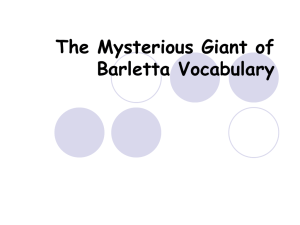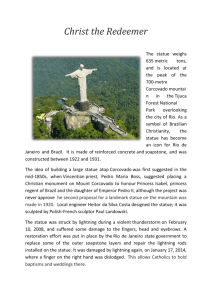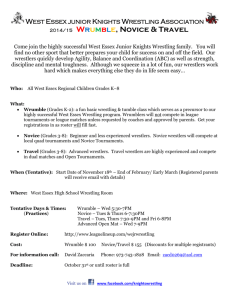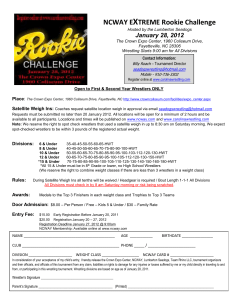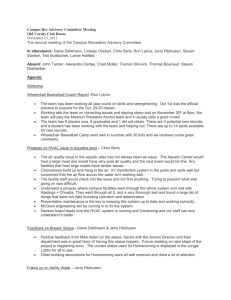Maria Anita Stefanelli
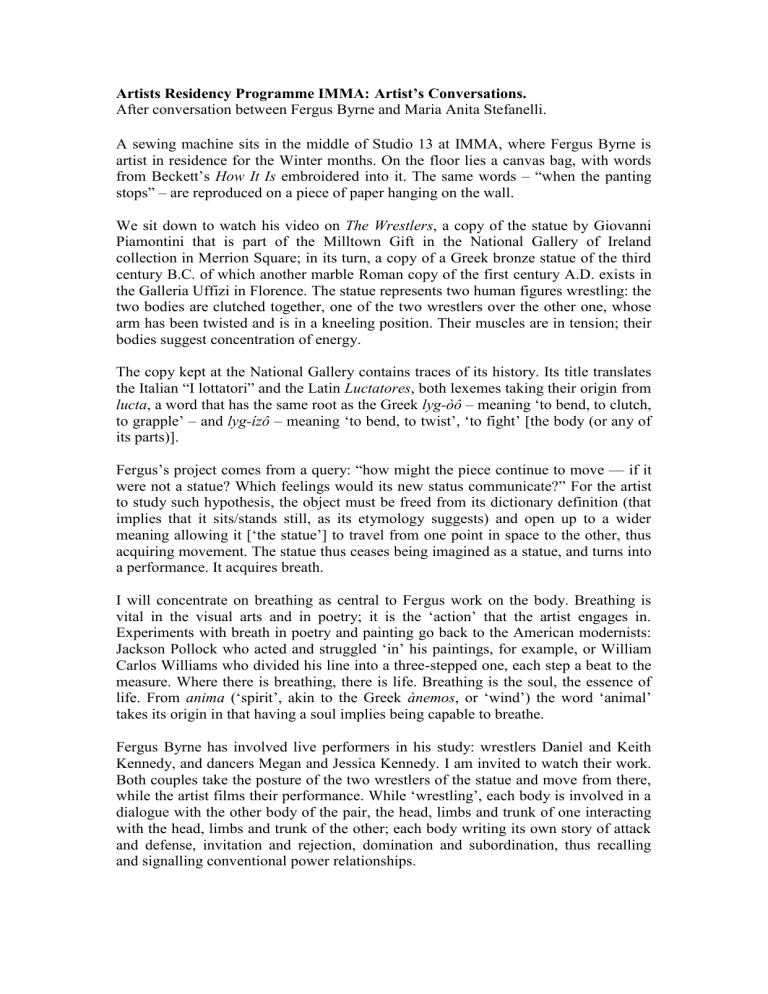
Artists Residency Programme IMMA: Artist’s Conversations.
After conversation between Fergus Byrne and Maria Anita Stefanelli.
A sewing machine sits in the middle of Studio 13 at IMMA, where Fergus Byrne is artist in residence for the Winter months. On the floor lies a canvas bag, with words from Beckett’s
How It Is embroidered into it. The same words – “when the panting stops” – are reproduced on a piece of paper hanging on the wall.
We sit down to watch his video on The Wrestlers , a copy of the statue by Giovanni
Piamontini that is part of the Milltown Gift in the National Gallery of Ireland collection in Merrion Square; in its turn, a copy of a Greek bronze statue of the third century B.C. of which another marble Roman copy of the first century A.D. exists in the Galleria Uffizi in Florence. The statue represents two human figures wrestling: the two bodies are clutched together, one of the two wrestlers over the other one, whose arm has been twisted and is in a kneeling position. Their muscles are in tension; their bodies suggest concentration of energy.
The copy kept at the National Gallery contains traces of its history. Its title translates the Italian “I lottatori” and the Latin Luctatores , both lexemes taking their origin from lucta , a word that has the same root as the Greek lyg-òô – meaning ‘to bend, to clutch, to grapple’ – and lyg-ízô – meaning ‘to bend, to twist’, ‘to fight’ [the body (or any of its parts)].
Fergus’s project comes from a query: “how might the piece continue to move –– if it were not a statue? Which feelings would its new status communicate?” For the artist to study such hypothesis, the object must be freed from its dictionary definition (that implies that it sits/stands still, as its etymology suggests) and open up to a wider meaning allowing it [‘the statue’] to travel from one point in space to the other, thus acquiring movement. The statue thus ceases being imagined as a statue, and turns into a performance. It acquires breath.
I will concentrate on breathing as central to Fergus work on the body. Breathing is vital in the visual arts and in poetry; it is the ‘action’ that the artist engages in.
Experiments with breath in poetry and painting go back to the American modernists:
Jackson Pollock who acted and struggled ‘in’ his paintings, for example, or William
Carlos Williams who divided his line into a three-stepped one, each step a beat to the measure. Where there is breathing, there is life. Breathing is the soul, the essence of life. From anima (‘spirit’, akin to the Greek ànemos , or ‘wind’) the word ‘animal’ takes its origin in that having a soul implies being capable to breathe.
Fergus Byrne has involved live performers in his study: wrestlers Daniel and Keith
Kennedy, and dancers Megan and Jessica Kennedy. I am invited to watch their work.
Both couples take the posture of the two wrestlers of the statue and move from there, while the artist films their performance. While ‘wrestling’, each body is involved in a dialogue with the other body of the pair, the head, limbs and trunk of one interacting with the head, limbs and trunk of the other; each body writing its own story of attack and defense, invitation and rejection, domination and subordination, thus recalling and signalling conventional power relationships.
With the statue acquiring life, the bodies reveal the issue of difference. Gender emerges as an important factor. Traditionally, wrestlers belong to a sort of patriarchal society where domination must be conquered in all fields. While the well-built bodies of the wrestlers grapple, bend, and /or twist one another, they fulfil the etymology of their wrestling function; they also produce a rhythmical movement of their mass as it turns on the floor.
As far as the bodies of the two female dancers are concerned, instead, their respective bodies are less in contact with one another and often assume a back-to-back contact position thus avoiding one another’s grappling and bending. They perform more independent movements.
It is important to note that the two women (who are twins) are not wrestlers, but dancers. Modern dance, wrote dance critic John Martin in the thirties, “has reinstated the ancient Greek tragic mode of conveying through the dancing body, ‘the
“inexpressible residue of emotion” which mere rationality … could not convey’
(Martin 1965: 18, 14). In postmodern dance, instead, the performers did not represent emotion, but rather presented movement with spontaneity and authenticity. Today, with the exploration of gender identity as a social construct, female dancers have become more and more ironical towards their own femininity while also transgressing previous forms of emotional expressions. Having fully emerged from patriarchy, they sometimes mix humour and transgression.
In the performance of the twins I noticed a pattern of contradictory ‘wrestling’ positions: clutching one another’s body as an invitation to wrestle, and then turning one’s back to one another as a refusal to wrestle. The pattern is one of acceptance and rejection, coming face to face and turning back to back, going towards and moving away from one another, as if the discourse they had engaged in was in perpetual evolution and contradiction.
While such pattern is a challenge to patriarchy, it is also a challenge to the sport of
‘wrestling’ as such. It defies the very definition of ‘wrestle’ as lucta ; or rather, it complies with it by satisfying its meaning, only to reject it by deliberately deconstructing it. Such contradiction is also in the relationship of the woman to her baby: she nurtures it within herself in her womb only to push it strongly out of her own body, when the time comes!
All bodies’ movements depend on breathing, of course. In a different project, Fergus
Byrne travels inside the canvas bag I mentioned at the beginning, struggling through it, sweating, panting, while the video broadcasts a descent through a cave or through the inside of a human body, and heart pulses are heard. The sewing machine appears every now and then, while it executes the needlework – each stitch perhaps symbolically associated with the suffering of the body (it is through a needle that the body may be wounded and it is through a needle that it can very often be cured, for that matter). Fergus’s is a voyage of the self, akin to Virgil’s and Dante’s, T. S.
Eliot’s, Ezra Pound’s, or in our days, many poets’ and writers’ descent into hell, and to the voyages of all those who are in search of themselves.
Dr. Maria Anita Stefanelli (Univ. Roma 3)
